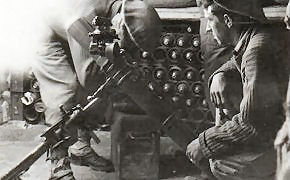The Chinese and North Korean used mainly 61mm, 82mm and 120mm high explosivemortar bombs to deliver to theirenemy ..... us! They were fired out of a tube, angled at between 45o(long distance) and about70o (a tripod kept the tube in place). One soldierheld the tube and fired it, and another soldier loaded bombs one ata time, tail first, into the tube. The weight of the bomb wouldtrigger the propellant in the tail by hitting a pin in the tube, thussending the bomb up on its deadly mission.
They travelled in their arc up and then down on to the enemy,travelling at less than the speed of sound, which is approximately740 mph (1069 fps). This allowed the "swoosh, swoosh"sound to travel ahead of the falling missile. The louder the soundthe closer to you the mortar was going to hit. A close mortarbomb explosion sounds like lightening has struck the ground nextto you, with a very loud ear splitting crack and a percussion airwave that could throw you over. Soldiers were often deafenedtemporarily or even permanently.
With its 9-82mm mortars, an enemy battalion could sustain an accuraterate of fire of over 180 rounds per minute. Often Australians and otherallies had mortar bombs falling about one every 30 seconds for up toone-hour barrages, 3000 bombs dropping over our front-line trenches andbunkers about one kilometre long. Quite often the enemy sent over mortarbombs at meal times while the soldiers were in their lines with their messtins held out ready for the cooks to throw some grub into them.The Chinese seemed to know exactly what time meals were givenout and exactly where. Perhaps they could see through the hillswith their X-Ray binoculars, or more likely there were spieswithin our camp.
In contrast to the Chinese, Australian mortar platoons used 2"(51mm) and 3 "(68mm) tubes to deliver bombs to deliver to the enemy,or else the American 60mm or 81mm mortar tubes. I onlyfired mortar bombs in training whilst in Australia, and Japan, anda little when we first came to Korea, just to brush up.
Every day there were stories in the camp about someone who hadcome close to a mortar. While crossing open ground behind "C"Company position, I heard the whoosh - whoosh, of a Chinesemortar coming down. I didn't have time to run for cover and justcrouched down where I was for protection. As I looked up I sawit was going to hit about 150 ft away, in a split second I saw a greycloud of dust and debris flying everywhere, and pieces makingbuzzing sounds flying through the air above me, but none actuallytouched me. This incident didn't upset me at all, probably becauseI was young and silly at only 20 years of age. I just wasn'tfrightened of mortars at that stage. The sharp crack howevernearly deafened me. It was about 2 days later that I realised thedanger of the mortars. I needed to relieve myself, so I went up tothe steel pipe in the ground which had lime around it to stop thesmells. When I was finished I started walking away whenwhoosh, a Chinese mortar exploded right next to the pipe where Ihad been. This time I gained my fear of mortars and from then onthey always made me jumpy.
We were sent up to "C" Company positions one day on one of ourusual digging parties to improve the trenches and "Hoochies"(dug-ins). I was in a "hoochie" and my mate Maurie Sharp was inone next to it. The Chinese saw the shovels of earth coming outover the trenches, and sent some mortars over to stop production.One burst on the bank above Maurie, so close to him that it sentthe tail complete with fins into the trench next to him. I heardhim yell and as he jumped out of the trench he said. "I'm bloodywell getting out of here-the Chinese have my range exactly". Hedidn't go back there all day. I said to him 35 years later, whydidn't you keep the tailing for a souvenir? But I guess at the timehe wasn't interested in memorabilia.
Authors Note: In Bosnia 1995 approximately 73 civilians werekilled and many more wounded in a market place, by one enemymortar bomb explosion.

60 mil mortar in night action
Courtesy of Cyril "Frenchy" Ray
|
|